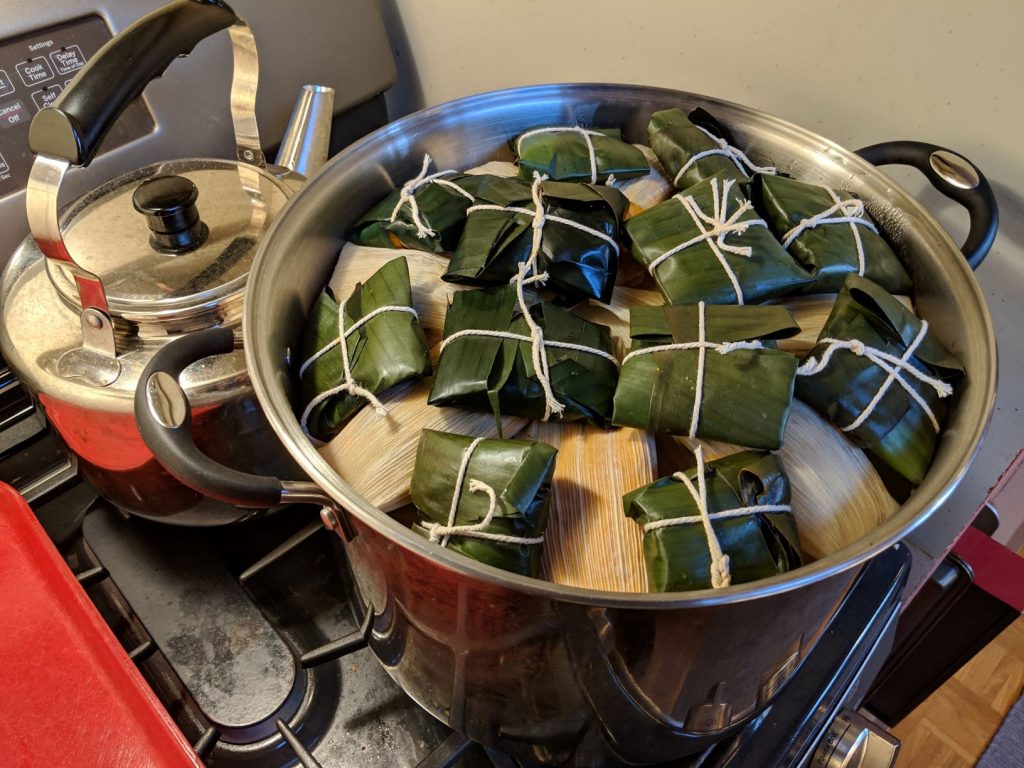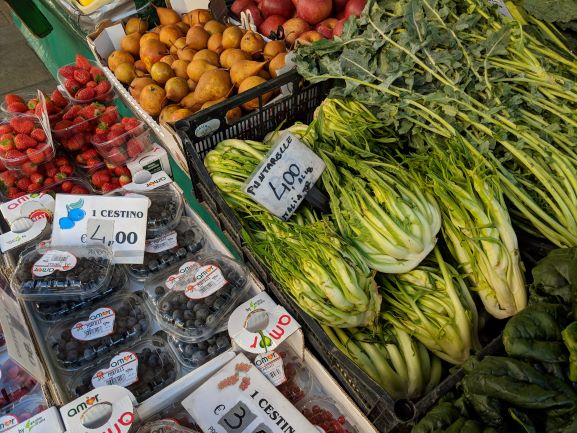Both Doug and Ruth like to cook, and to eat. Photos and a few recipes, too.
Ruth’s version of high hydration sourdough bread, the slow way:
After retiring, I decided to take on bread making, since we live so far from a grocery store; good bread is also quite expensive. At the recommendation of a friend, I worked on the no-knead bread approach. Although I was able to make good loaves, there were issues that seemed due to high altitude. When Doug’s cousin Lyndall visited, bringing her sourdough starter, I finally approached this ancient bread. I love the resilience of sourdough. Gleaning tips from books and the internet, this is what I do:
Ruth’s High Hydration Sourdough, including olive bread
I take it really slowly, which makes it fit into my days without overwhelming me. Be forgiving of yourself.
DAY 0: Feed starter in the afternoon, half flour, half water (starter is kept in the fridge)
DAY 1:
I do weigh ingredients, for a “high hydration” sourdough loaf: 500 g flour, 390 g water (works for me), 1-1.5 tsp salt, 1/3 cup starter. I use our well water that has been filtered to remove more minerals. Regular well water may work just the same.
Mix the water into the starter with a silicon spatula, then add the flour (with salt mixed in), slowly mixing. If there are already dry spots, use a little more water. Cover bowl with a damp towel. Let sit on the counter.
After 1 hr, I do something that is sort of like kneading, but not exactly. I found a little moon shaped scraper, and I rotate the bowl while turning the nascent dough over slightly. Oops, before I do this, I patch any dry spots with a little water on my finger.
About every 2 hr, I “knead” with the scraper, rotating the bowl, folding over as I turn the bowl. Cover again. Leave on the counter.
Evening DAY 1:
Scrape the dough out onto a floured surface and dimple it. Leave for ca. 10 minutes, then fold over, turning the dough around (or my hand). Cuddle it up. Flip it over and place in pan. I use parchment paper, because it keeps the bread from sticking.
Pan or Pot?? You can use a dutch oven (metal handle on lid) or a bread pan. The methods of baking are slightly different, but definitely line with parchment paper.
Put the pan or pot in the refrigerator covered by a damp towel (or two, plus a sheet of waxed paper).
DAY 2:
Refresh the damp towels with water as needed, in the morning and evening.
DAY 3:
Take the bread dough out of the fridge, and gently rub with flour. Slash at a slight angle with a sharp knife or blade. I’m afraid of razor blades or the expensive tools breadmakers use, so I use an old knife that I sharpen, then leave in the refrigerator. The dough is quite resilient at this point, so if the surface isn’t really cut, it won’t pop up or have “ears” (Sometimes I don’t have ears). However, the bread WILL rise in the oven and be wonderful to eat.
If you have a metal bread pan, I start the bread in the oven at 425º (add hot water to a pan on the shelf underneath before you shut the oven door), then reduce to 400. Remove from pan after about 40 minutes (peel off parchment paper) and place on oven rack to finish browning for the last 10 minutes. I recommend long sleeves and gloves. Sometimes I use a higher temperature.
If you use a covered dutch oven or such, set the oven at 500º, then lower to 450º after about 5 minutes. I recently found out that you can put it right into a cold oven, set to 500º. Lower to 450º when it reaches temperature (ca. 27 minutes in my oven). Remove the cover after about 40 minutes. The last 10 minutes are with the bread bare on the oven rack. Everything will take 60-70 minutes. Sometimes I make a larger loaf, which might take another 10 minutes.
This is what works for me at 5,000 ft.
I have tried with some whole wheat flour as about a quarter of the flour.
We also like olives in the bread. I work the olives in after the first hour of setting, above. They tend to pop out of the dough at first (I cut them in pieces), but that will work itself out.
I was able to make a baguette-like structure without the extra work.
Some of the above instructions I found here and there on the internet or in another cookbook.
Sourdough is very forgiving, so you can be, too.
PS: Wash your hands a lot.
Dark Sourdough Bread
Ingredients: 200 g white flour (Wheat Montana), 200 g whole wheat flour (Wheat Montana Bronze Chief), 100 g dark rye flour (Bob’s Red Mill), 400 g water, 1 tsp salt, a scant teaspoon of diastatic malt power (King Arthur Flour), ½ cup starter.
After an hour, add molasses (dip large spoon into jar and transfer quickly to dough), and knead the dough with the bowl scraper. This will take more time.
The rest of the recipe is the same.
Special Raisin Bread
Ingredients: 500 g white flour, 400 g water, 1 tsp salt, 1 T cacao powder, 2 T PB powder, ½ tsp cinnamon, ½ cup starter. Soak 1 cup raisins in water.
Same method.
Add the vanilla just after mixing the water in the starter.
Mix the dry ingredients with the flour before adding to the starter/water mixture.
When it is time to first fold over the dough (ca. 1 hour), drain the raisins, and fold them into the dough. Eventually, as you fold the dough over the day, they will mix in well.
This doesn’t taste sweet, and works well with savory items as well as sweet.
Raisin-filled Homely Cookies
Raisin-filled Homely Cookies
(adapted by Helen Fritz from a recipe passed down from her mother-in-law via daughter Arleen Gartrell)
Read the recipe before starting.
The raisin mixture should be made in advance and chilled until the mixture is thick enough that a spoon will (almost) stand upright from the middle of the pot.
1 lb raisins
2 cups sugar
2 cups water
Cook and put about 2 T of flour in the water, and stir until thickened. Add more if needed. If this mixture is not thick enough the cookies will be a runny mess.
2 eggs, beat white separately
1 cup butter
2 cups sugar
Cream butter and sugar, then add egg yolks.
1 cup sweet milk (or whole milk or half & half), add, mix
4 to 7 cups of SIFTED flour (Ha! That’s what the recipe says.)
4 tsp baking powder
½ tsp salt
2 tsp vanilla
When you start adding flour, switch to a dough hook.
Sister-in-law Arleen uses 4 cups of flour.
Fold in beaten egg whites carefully. Dough will be sticky.
Work in the rest of the flour until you can handle the dough. You may not use all of the flour.
Roll out on a floured surface to slightly less than ¼ inch thickness and cut round cookies, 2 to 2.5 inch circles)
Use parchment paper on cookie sheets.
Put a teaspoon or more of the raisin filling on one circle, and cover with another, making a sandwich.
Seal the edges.
Place on a baking sheet about 2 inches apart.
Bake at 400° for about 15 minutes.
Cookies will rise and get larger.
Let cool on a rack.
Eat slowly.
Sourdough Hamburger Buns
This recipe is adapted from King Arthur Flour, without milk, and with some changes for high altitude.
In the mountains, this can be done in one day, if started early.
Mix thoroughly:
240 g white flour (Wheat Montana)
28 g dark rye flour (Bob’s Red Mill)
25 g potato flour
1.5 tsp salt
1 T sugar
Soften 4 T butter.
¾ cup sourdough starter
1 cup oat milk, warmed to ca. 75-80°
Mix starter and oat milk.
Add dry ingredients slowly.
When mixed (and no dry spots), mix in the softened butter.
Let rest, covered with a damp towel, for 1 hr.
Fold with a bowl scraper. Fold again for 3 more times.
After 6 hr, fold onto a floured surface. Poke. Let rest 5-10 minutes.
Divide into 6 parts.
Tuck each piece of dough into a ball and place on parchment paper.
Pat.
Cover with a towel.
Let rise for ca. 4 hr.
Bake at 375° for 25-30 min. Add hot water to a tray on bottom shelf to create steam.
Internal temperature should be at least 190°




